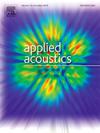Using time reversal with long duration broadband noise signals to achieve high amplitude and a desired spectrum at a target location
IF 3.4
2区 物理与天体物理
Q1 ACOUSTICS
引用次数: 0
Abstract
Time Reversal (TR) is a signal processing technique that can be used to focus acoustic waves to a specific location in space, with most applications aiming to create an impulsive focus. This study instead aims to focus long-duration noise signals using TR. This paper seeks to generate higher amplitude noise at a desired location over an existing method of broadcasting equalized noise. Additionally, this paper explores various characteristics associated with focusing long duration noise using TR. The dependence of the focal amplitude on the duration of the focused signal is explored as well as the implications of using multiple sources when focusing noise. The focal amplitude decreases with longer duration and then levels off when the duration exceeds a few seconds. Coherent addition of focused noise is observed if all loudspeakers have coherent noise signals convolved with their reversed impulse responses. Lastly, focusing noise with a desired spectrum is explored.
利用时间反转与长持续时间宽带噪声信号在目标位置实现高幅度和所需的频谱
时间反转(TR)是一种信号处理技术,可用于将声波聚焦到空间中的特定位置,大多数应用旨在产生脉冲聚焦。相反,本研究旨在使用TR聚焦长时间噪声信号。本文试图在现有的广播均衡噪声方法之上,在期望的位置产生更高幅度的噪声。此外,本文还探讨了使用TR聚焦长持续时间噪声的各种特性。探讨了聚焦振幅对聚焦信号持续时间的依赖关系,以及在聚焦噪声时使用多个源的影响。震源振幅随持续时间的延长而减小,当持续时间超过几秒后趋于平稳。如果所有扬声器都具有与其反向脉冲响应卷积的相干噪声信号,则可以观察到聚焦噪声的相干附加。最后,研究了具有理想光谱的聚焦噪声。
本文章由计算机程序翻译,如有差异,请以英文原文为准。
求助全文
约1分钟内获得全文
求助全文
来源期刊

Applied Acoustics
物理-声学
CiteScore
7.40
自引率
11.80%
发文量
618
审稿时长
7.5 months
期刊介绍:
Since its launch in 1968, Applied Acoustics has been publishing high quality research papers providing state-of-the-art coverage of research findings for engineers and scientists involved in applications of acoustics in the widest sense.
Applied Acoustics looks not only at recent developments in the understanding of acoustics but also at ways of exploiting that understanding. The Journal aims to encourage the exchange of practical experience through publication and in so doing creates a fund of technological information that can be used for solving related problems. The presentation of information in graphical or tabular form is especially encouraged. If a report of a mathematical development is a necessary part of a paper it is important to ensure that it is there only as an integral part of a practical solution to a problem and is supported by data. Applied Acoustics encourages the exchange of practical experience in the following ways: • Complete Papers • Short Technical Notes • Review Articles; and thereby provides a wealth of technological information that can be used to solve related problems.
Manuscripts that address all fields of applications of acoustics ranging from medicine and NDT to the environment and buildings are welcome.
 求助内容:
求助内容: 应助结果提醒方式:
应助结果提醒方式:


